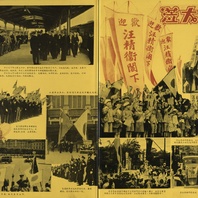
Item
An di Dongjing; li dashiguan (Arriving safely in Tokyo; visiting the embassy)
This photomontage is taken from Huang Qingshu (ed), Wang zhuxi fang Ri jinian huakan (Special pictorial in commemoration of Chairman Wang’s visit to Japan) (Nanjing: Xuanchuanbu, 1941). It includes images of Wang Jingwei arriving in Tokyo during his 1941 visit to Japan, and specifically his visit to the RNG embassy in Tokyo.
Read More
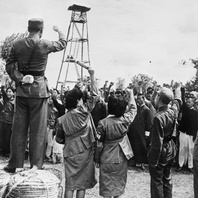
Item
Rural Pacification cadres rousing peasants
Photograph of members of the RNG Central Propaganda Group’s Number 2 Rural Pacification Propaganda Team leading a rural audience in the shouting of slogans. The photograph was possibly produced by the RNG’s Central News Agency. Note the watchtower in the background flying the Nationalist Chinese flag, suggesting this photograph was taken in a “pacified village”.
Read More
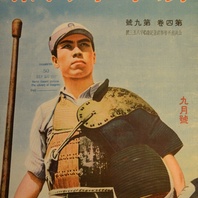
Item
Xin Zhonghua huabao (New China Pictorial) cover, September 1942
This cover image from the New China Pictorial 4.9 (September 1942) shows an unnamed member of the Chinese collaborationist forces in the outfit of a kendoka. There is little to identify this image (almost certainly created by the news agency Dōmei, as it was used as the cover image for the Japanese-language Dōmei Graph in October 1942) as being of a Chinese man, other than the inclusion of the Nationalist Chinese (white sun) insignia on his cap. The same image was used in later propaganda celebrating the collaborationist government’s declaration of war on the Allies. This was the only cover image from this magazine which included a male figure. The New China Pictorial was a bilingual (Chinese-English) published from 1939 through 1944 in Shanghai by the occupation journalist Wu Linzhi for distribution in China and throughout Southeast Asia.
Read More
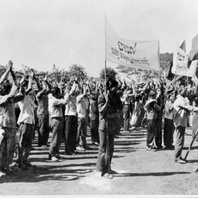
Featured Item
Crowd celebrating the Kampuchea United Front for National Salvation
This photograph shows people cheering the programme of the Kampuchea United Front for National Salvation (KUFNS, also known as FUNSK) [Front or Renakse]. It may have been taken in Kratie on 2 December 1978. It was featured in the publication (French and English versions) entitled The People’s Republic of Kampuchea (1979). This photograph is part of the collection held by the Agence Khmère de Presse (AKP) and Cambodia’s Ministry of Information. This collection, which documents the early years of the People’s Republic of Kampuchea as photographed by the Vietnamese and a small team of Cambodian photographers, has not yet been classified or indexed.
Read More
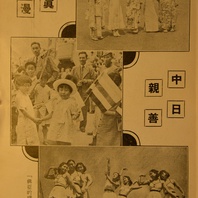
Item
Zhong-Ri qinshan, tianzhen lanman (Sino-Japanese amity, innocent and unaffected)
This series of unattributed photographs is taken from the Daminhui publication Xin Zhongguo (New China) 3.1 (January 1940). They are used here to present scenes of “Sino-Japanese friendship”. In the top two images, Chinese and Japanese children greet each other and waves the flag of Japan and of the Reformed Government of the Republic of China (RGROC). In the image at the bottom of the page, some unnamed performers do an “autumn dance” (qiu wu) entitled “Xing Ya de shuguang” (The light of a revitalized Asia).
Read More
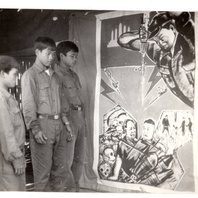
Featured Item
Three men looking at a propaganda poster
This picture shows three young male soldiers looking at a poster that represents a soldier of the Kampuchea United Front for National Salvation (KUFNS, also known as FUNSK) [Front or Renakse] aiming his rifle with bayonet at the enemies, Pol Pot and Ieng Sary. The drawing next to Pol Pot’s head is a reproduction of a photograph of killings by Khmer Rouge guards that were published between April 1976 and January 1978 in the mainstream Western media. Different stories circulated about the origin of those pictures. Some said they had been smuggled out of Cambodia by a relative of the photographer, who himself had died while trying to escape, or by a Cambodian refugee in Paris who refused to reveal his identity. According to Sygma Photo News (the agency which had distributed the original pictures), the images came from Khmer Rouge defectors. In fact, the photos had first appeared in a Thai newspaper in April 1976 and were reprinted in the Bangkok Post under the headline “True or false?” a few days later. The newspaper explained that they had first refused to buy the images from the Thai trader who tried to sell them because they had doubted their authenticity. Even American intelligence services thought the pictures were fake. The photographs, it turned out, were part of an operation by the Thai intelligence services. They had been staged and taken in Thailand. This photograph is part of the collection held by the Agence Khmère de Presse (AKP) and Cambodia’s Ministry of Information. This collection, which documents the early years of the People’s Republic of Kampuchea as photographed by the Vietnamese and a small team of Cambodian photographers, has not yet been classified or indexed.
Read More
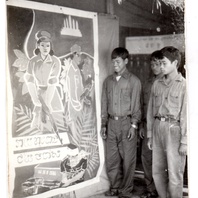
Featured Item
Three men beside a propaganda poster
This photograph shows of three young soldiers standing next to a poster representing two soldiers (a man and a woman) from the Kampuchea United Front for National Salvation (KUFNS, also known as FUNSK) [Front or Renakse] fighting against the Khmer Rouge-Chinese enemy. The three soldiers stand at the entrance to a hut. The poster is about 1.80 metres in height. It is pinned on the hut’s external wall. It shows a female soldier and a male soldier standing below the Kampuchea United Front for National Salvation flag. The female soldier points her rifle to the bottom of the poster, at the enemy. The latter is clad in black and wears a krama (traditional scarf). He is obviously a Khmer Rouge fighter. The writing in Khmer, at the centre of the poster, reads: “Fight for victory”. This photograph is part of the collection held by the Agence Khmère de Presse (AKP) and Cambodia’s Ministry of Information. This collection, which documents the early years of the People’s Republic of Kampuchea as photographed by the Vietnamese and a small team of Cambodian photographers, has not yet been classified or indexed.
Read More
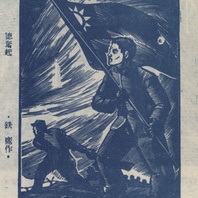
Item
Zong fenqi (Uprising)
This woodcut, by an artist called Tie Ying (lit. “iron eagle”), was reproduced in Zhonghua huabao (Chinese Pictorial) 2.2 (March 1944). The importance of the muke (woodcut) form to artistic practice in occupied China has been almost entirely overlooked in the literature. The muke form has hitherto been associated with the art of resistance in China, despite being an important part of “occupation” visual cultures as well. In this case, the image of Chinese men, dressed in their “New Citizens Uniforms” (Xin guomin zhifu) and waving the ROC flag as they run into battle against enemies unseen, looks almost identical to early wartime resistance muke.
Read More
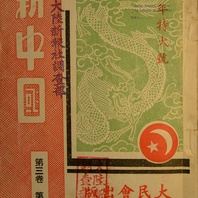
Item
Xin Zhongguo (New China) cover, January 1940
This is the cover image of the magazine Xin Zhongguo (New China) 3.1 (January 1940), published by the Daminhui (Great People’s Association) in Nanjing. The Daminhui was a propaganda and mobilization organization established by the Japanese in 1938, which was later folded into Wang Jingwei’s Kuomintang (Nationalist Party). The Daminhui specialised in public expressions of support for the occupation, and employed a staff of Chinese organisers, artists, and writers. The sun-and-moon logo of the Daminhui can be seen on this magazine’s cover. The untitled woodcut image of the dragon is unattributed. It is included here to coincide with the New Year (which this issue of Xin Zhongguo celebrates). Significantly, text on the magazine’s cover suggests that this copy of New China was once owned by investigations department of the Japanese-language, China-based newspaper, the Tairiku Shinpō.
Read More
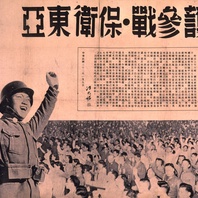
Item
Yonghu canzhan, baowei Dong Ya (Support the declaration of war; defend East Asia)
Poster of Chinese soldier celebrating the declaration of war on the Allies by RNG China. The poster reads “Yonghu canzhan, baowei Dong Ya” (Support the declaration of war; defend East Asia), and includes the text of Wang Jingwei’s declaration of war on the Allies on 9 January 1943. Note that some postwar owner of this poster has written “wei guomin zhengfu” (bogus National Government) to the right of the text by Wang Jingwei so as to clarify which Chinese administration was declaring war on this occasion.
Read More
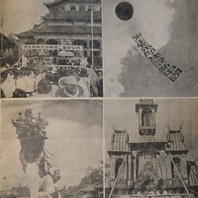
Item
Celebratory ceremony marking the second anniversary of Guangdong’s ‘rebirth’
This series of photographs is taken from Huanan huabao (South China graphic) 2.6 (1940), and shows celebrations to mark the second anniversary of what the Japanese referred to as the “rebirth” of Guangzhou (i.e., the fall of Guangzhou) in October 1938. Note the prominence given to the Sun Yat-sen Memorial Hall, as well as the use of “folk” forms of cultural expression.
Read More
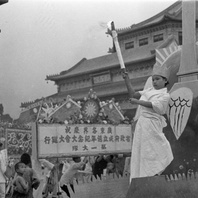
Item
Untitled (Boy dressed as angel of peace)
A boy is dressed as the “angel of peace” and rides on a float during celebrations marking the first anniversary of the founding of the Guangdong Provincial Government under Wang Jingwei in May 1941. The building in the background is the city’s Sun Yat-sen Memorial Hall (Zhongshan jiniantang).